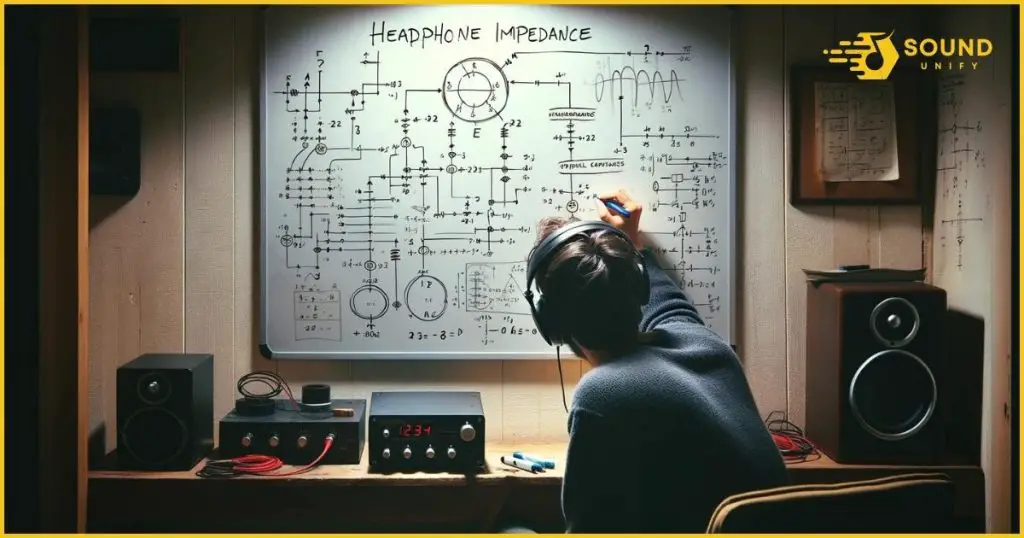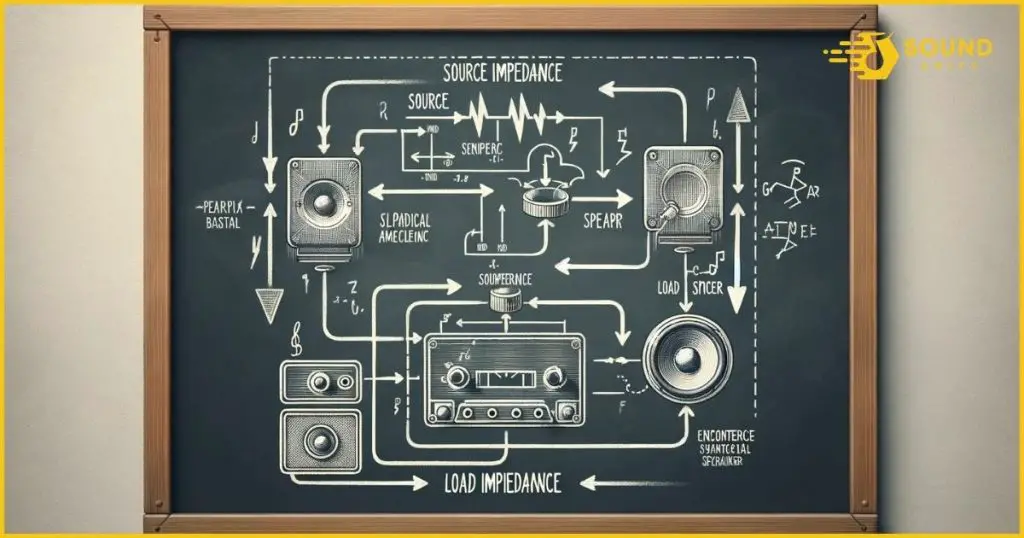In the world of audio equipment, headphones are a popular choice for experiencing music, movies, and gaming. When choosing headphones, one of the essential specifications to consider is impedance.
The concept of impedance can be a bit confusing, but understanding it is crucial for selecting the right pair of headphones and optimizing sound quality.
In this guide, we will explore the world of headphone impedance. Its role in audio reproduction, high and low impedance impact on audio quality, the science behind impedance matching, and much more.
Whether you are a seasoned audiophile or a casual listener, this guide will help you master the world of headphone impedance.
Read more: Learn About Headphones
The Concept of Impedance in Headphones

Impedance refers to the electrical resistance of a device. In practical terms, impedance lets you know whether or not you’ll be able to pair your headphones with a battery-powered device like a smartphone.
In the context of headphones, impedance determines how much power the headphones require to produce sound. It is measured in ohms (Ω).
The impedance of a headphone affects its compatibility with different audio sources and can impact sound quality.
Regarding headphone impedance, there are two main categories:
- High-impedance headphones
- Low-impedance headphones
Impact of High and Low Impedance on Audio Quality
The impedance of headphones directly impacts the quality of sound reproduction.
The choice between high and low-impedance headphones depends on various factors, including the audio source and personal listening preferences.
1. High-Impedance Headphones
High-impedance headphones, typically 100 to 600 ohms, offer several advantages for audio enthusiasts. These headphones provide better sound quality, with improved clarity, accuracy, and detail, especially when paired with quality audio equipment and headphone amplifiers.
High-impedance headphones are commonly used in professional audio applications, such as studio monitoring, where audio fidelity is paramount.
Characteristics of High-Impedance Headphones:
- Designed for superior sound quality, it is ideal for recording studios and music production.
- High-impedance models like Beyerdynamic DT and Sennheiser HD series require a quality audio source.
- It may necessitate a headphone amplifier to unlock its full potential due to high sensitivity.
- Excel at delivering detailed, accurate, and nuanced sound.
- Feature wider frequency response ranges for subtle audio detail reproduction.
- It is favored by audio professionals, musicians, and avid music enthusiasts for sound quality and fidelity.
2. Low-Impedance Headphones
On the other hand, low-impedance headphones, usually 16 to 32 ohms, are designed for portable devices, such as mobile phones and portable music players.
They are more efficient in power consumption, making them ideal for on-the-go listening. Low-impedance headphones can be driven easily by most portable devices without additional amplification.
Characteristics of Low-Impedance Headphones:
- Efficient power consumption is suitable for mobile devices like smartphones and laptops.
- They are easily driven without additional amplifiers, which is ideal for portable listening.
- Versatile and compatible with a wide range of audio sources.
- Reliable sound output for music, movies, and DJing without compromising audio quality.
- They are preferred by DJs and performers for headphone monitoring during live shows.
- Lightweight, portable, and easy to carry, perfect for travelers and commuters.
- Popular among casual listeners for convenience and ease of use on the go.
When choosing between high and low-impedance headphones, it’s important to consider your listening preferences, audio source and desired sound quality. Understanding the impact of impedance on audio quality allows you to make an informed decision and select headphones that best suit your needs.
Role of Ohms in the Functioning of Headphones
The ohm rating of headphones plays a crucial role in their functioning. It indicates how much power the headphones require from the audio source, also known as the source voltage.
Higher-impedance headphones, typically above 100 ohms, require more power, while lower-impedance headphones, usually below 32 ohms, require less energy. The impedance of headphones impacts how loud and clear the audio will be.
The Science Behind Impedance Matching

Impedance matching is a fundamental concept in electrical engineering, and it plays a significant role in audio systems, including headphones.
In simple terms, impedance matching involves harmonizing electrical resistance between devices, such as an audio source and headphones.
Proper impedance matching ensures efficient power transfer, minimizes signal loss, and maximizes the quality of sound reproduction.
Regarding headphone audio, impedance matching refers to matching the impedance of the audio source (source impedance) with the impedance of the headphones (load impedance).
Understanding the science behind impedance matching helps you achieve optimal sound quality and ensures a seamless audio experience.
The Principle of Impedance Matching
The impedance matching principle involves aligning the audio source’s output impedance with the headphones’ load impedance.
The output impedance refers to the electrical resistance of the audio source, while the load impedance refers to the headphones’ impedance.
- Impedance matching aims to achieve the best possible power transfer, avoiding reflections or signal loss. When the output impedance and load impedance are matched, the power delivered from the audio source is efficiently transferred to the headphones.
- The output impedance of the audio source should ideally be much lower than the load impedance of the headphones. A significant impedance mismatch can lead to inefficient power transfer. This causes a decrease in volume, loss of audio quality, or even potential damage to the audio equipment.
The principle of impedance matching helps you optimize power transfer and ensure the best possible audio performance.
You can achieve a seamless audio experience by matching impedance levels and preventing any impedance-related issues.
Importance of Impedance Matching in Headphones
Impedance matching is crucial for headphones, directly impacting audio quality and performance. Proper impedance matching ensures optimal sound reproduction and prevents audio distortion or inefficiency.
Matching the impedance of the headphones with the audio equipment allows for efficient power transfer, balanced frequency response, and accurate audio representation. It helps achieve a balanced audio signal, enhancing the listening experience by preserving the audio fidelity.
Impedance matching becomes essential in scenarios where high-quality sound reproduction is desired, such as professional audio production or critical listening environments. It ensures that the headphones receive the appropriate power levels, improving clarity, detail, and dynamics.
On the other hand, improper impedance matching can lead to several issues, including:
- Loss of volume
- Poor sound quality
- Potential damage to equipment
By paying attention to impedance matching, you can optimize audio performance, enhance sound quality, and enjoy a more immersive listening experience.
The Relationship Between Headphone Sensitivity and Impedance

Headphone sensitivity and impedance are two specifications that work hand in hand to define the overall audio experience. While impedance determines the power requirements of headphones, sensitivity rating indicates how loud the headphones can get.
Headphone sensitivity is measured in decibels of sound pressure level (dB SPL) per 1 milliwatt of power. Defines the headphone’s efficiency in converting electrical signals into sound. Higher-sensitivity headphones amplify sound more effectively, requiring less power to reach a reasonable listening volume.
About impedance, sensitivity rating plays a crucial role in determining the audio output of headphones. A balance between sensitivity and impedance levels ensures optimal sound reproduction, volume control, and overall audio quality.
It’s important to note that sensitivity and impedance are not directly interchangeable, and both specifications should be considered when selecting headphones that meet your audio preferences.
Exploring the Frequency and Impedance Connection
Frequency response and impedance are interconnected aspects of headphones that play a vital role in sound reproduction and audio quality.
Frequency response refers to the range of frequencies that headphones can accurately reproduce. Impedance specifications provide insights into how headphones handle different frequency ranges, indicating their sensitivity to specific frequencies.
The impedance of headphones can impact how well they handle specific frequency ranges, including resonant frequencies. Each headphone driver has a resonant frequency, which produces a peak response.
This affects the sound signature and tonal balance of the headphones. Understanding the frequency and impedance connection helps select headphones suitable for different music genres and listening preferences.
Resonant Frequency in Different Types of Headphones
The resonant frequency is critical for headphone drivers, influencing their performance characteristics and overall sound quality.
Different types of headphones, such as dynamic drivers, planar magnetic drivers, or electrostatic drivers, have unique resonant frequency properties.
The resonant frequency of a headphone driver refers to the frequency at which it naturally resonates, resulting in a peak response in its frequency response curve.
Understanding resonant frequency aids in selecting headphones that resonate well with your music preferences. It influences the tonal balance, sound signature, and frequency response characteristics of headphones.
By matching resonant frequencies with your individual listening preferences, you can enhance the overall audio experience and enjoy music as intended to be heard.
It’s important to note that resonant frequency is not the only factor determining sound quality, but it plays a part in differentiating headphone models and sound profiles.
The Interplay Between Source and Load Impedance

The interplay between source and load impedance is critical regarding headphone audio.
- Source impedance refers to the electrical resistance of the audio source, while load impedance refers to the impedance of the headphones. The relationship between these impedance levels affects power transfer and audio signal transmission.
- Higher source impedance can make it more difficult for headphones to draw power from the audio device. On the other hand, lower headphone impedance requires less voltage to drive the headphones effectively.
Balancing source and load impedance ensures efficient power transfer, producing optimal volume, sound quality, and overall headphone performance.
This interplay between source and load impedance is crucial in understanding the output voltage needed to drive headphones effectively.
The interplay between source and load impedance helps select audio equipment that pairs well with specific headphones. By considering source and load impedance, you can optimize:
- Power delivery
- Prevent impedance mismatch-related issues
- Ensure a seamless audio experience
Challenges with High Source Impedance and Low Headphone Impedance:
- Mismatched Impedance Levels: High source and low headphone impedance can cause challenges in audio systems.
- Damping Factor Issues: High source impedance leads to a lower damping factor, reducing control over headphone drivers.
- Sound Quality Degradation: Results in inaccurate sound reproduction, poor bass response, and overall quality degradation.
- Inefficient Power Transfer: Low headphone impedance with high source impedance can decrease volume levels and sound quality.
- Risk of Damage: Potential harm to headphones or audio equipment due to impedance mismatch.
- Importance of Matching: Matching headphone and audio device impedance is essential for optimal power efficiency, signal clarity, and fidelity.
- Optimal Listening Experience: Ensuring proper impedance balance resolves various issues, enhancing the audio experience.
To overcome these challenges, it is essential to match headphone impedance with the output impedance of the audio devices.
Doing so can resolve power efficiency, signal clarity, and audio fidelity issues, resulting in an optimal listening experience.
Does a Headphone Amplifier Improve the Sound Quality of High-Impedance Headphones?
Headphone amplifiers enhance high-impedance headphones’ sound quality, volume, and overall performance.
High-impedance headphones, such as those with impedance levels above 100 ohms, require more power to operate efficiently.
While portable audio devices can power low-impedance headphones adequately, they may struggle to provide enough power for high-impedance headphones. This reduces sound quality, lower volume levels, or audio distortion.
A headphone amplifier, designed specifically for driving headphones, can deliver higher output power, ensuring efficient power transfer to high-impedance headphones.
This improved power delivery results in better sound dynamics, cleaner sound reproduction, enhanced detail, and overall audio fidelity.
Using a headphone amplifier with high-impedance headphones unlocks their full potential, optimizing sound quality and allowing you to enjoy music or audio content as the producers intended. Choosing a headphone amplifier suited for your specific headphones is essential, considering impedance, power output, and audio quality requirements.
What is the 1/8 rule for headphone impedance?
The 1/8 rule is a practical guideline for matching headphone impedance with the output impedance of audio sources, ensuring optimal power transfer and audio fidelity.
According to the 1/8 rule, the output impedance of the audio source should ideally be at least 1/8th of the headphone impedance.
For example, if you have headphones with an impedance of 32 ohms, the output impedance of your audio device should be below 4 ohms.
Adhering to the 1/8 rule minimizes the potential for impedance mismatch issues, such as:
- Frequency response variations
- Unwanted resonances
- Sound quality degradation
It ensures efficient power transfer, prevents reflections, and preserves signal integrity between the audio source and headphones.
It is important to note that this rule of thumb is a practical suggestion. Other factors are:
- Amplifier damping factor
- Headphone sensitivity
- Sound preferences
One crucial factor is the source output impedance, significantly affecting your headphones’ frequency response and overall sound quality.
Considering the 1/8 rule, you can achieve a proper impedance match, prevent impedance-related issues, and optimize sound quality when using headphones with different impedance levels.
FAQs
Do higher-impedance headphones sound better?
Higher-impedance headphones may not always offer superior sound quality as they demand more power. Factors like drivers and design influence sound output, while matching impedance with the device can affect audio. Personal preference and usage must guide your choice of headphone impedance.
What is a good impedance level for headphones?
For headphones, portable devices’ optimal impedance level typically ranges from 16 to 32 ohms. Meanwhile, studio or home use often calls for 250 ohms or more headphones.
Is higher or lower headphone sensitivity better?
Higher sensitivity is ideal for low-power devices like smartphones when considering headphone sensitivity. Conversely, lower sensitivity suits high-power equipment such as amplifiers. This metric, measured in dB SPL per 1mW of power, should align with the intended usage and power source for optimal performance.
Conclusion
Understanding headphone impedance is crucial for optimizing audio quality. Whether high or low impedance, each type uniquely impacts sound reproduction. Matching the impedance between your source and headphones is vital to achieving the best performance.
Consider headphone sensitivity too, as it affects volume levels. While high-impedance headphones may offer better sound quality, they require a powerful amplifier.
The 1/8 rule guides choosing the right impedance level. By mastering impedance, you can tailor your headphone setup to your preferences and enjoy an immersive audio experience like never before.
James Dimento is a Chief-in-Editor of SoundUnify. He is a headphone enthusiast and creative writer passionate about audio technology. He has three years of experience writing about headphones and sound quality and is responsible for creating reviews and taking care of all administration.
